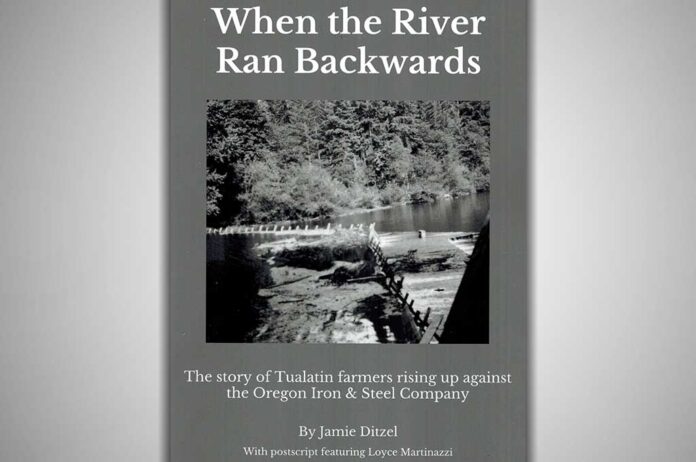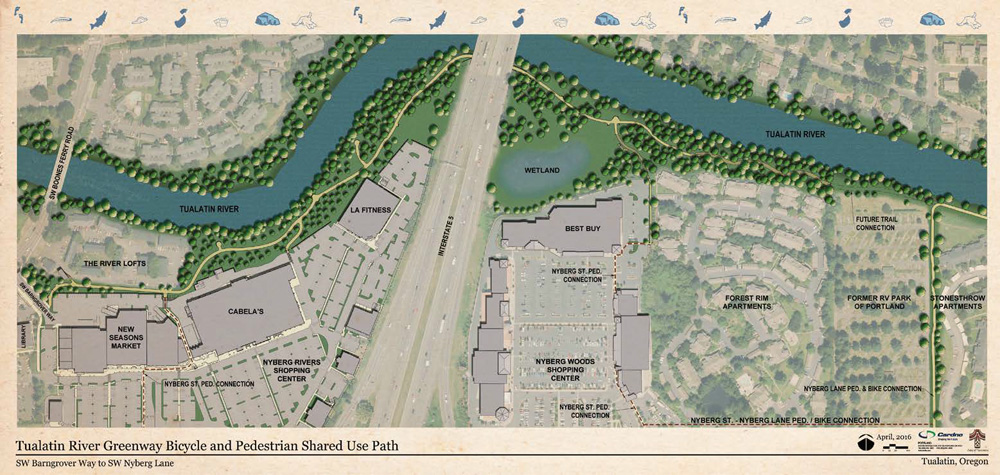
New book details revolt against Oregon Iron & Steel Company
Some stories are so unbelievable that they deserve to be told over and over. One such story is how a group of farmers in Tualatin in 1906 blew up a dam on the Tualatin River constructed by the Oregon Iron & Steel Company.

Now the story has been published in a new book called “When the River Ran Backwards” by Jamie Ditzel. It is available for sale at the Tualatin Historical Society’s Heritage Center.
Knowing the history of what led to the dam being blown up is critical to understanding why the farmers took matters into their own hands after the legal system failed them. But Ditzel first reminds readers that the story took place on land stolen from the Kalapuya and Atfalati peoples who originally lived there.
In 1865 the Oregon Iron Company was founded and purchased a tiny forge in Oswego that had opened in 1862 for the smelting of iron made from Oswego ore. In 1866 the Oregon Iron Company built the first charcoal iron smelter on the West Coast, named Oregon Iron Furnace.
In 1871, the Tualatin River Navigation and Manufacturing Company purchased a sawmill built by Albert Alonzo Durham, who also constructed a small dam on Sucker Creek at the east end of Sucker Lake (renamed Oswego Lake in 1913). The company then constructed a canal connecting the Tualatin River with the west end of Sucker Lake to create a continuous waterway to transport Tualatin Valley crops and lumber to Portland.
In 1877, Oregon Iron Furnace was sold. It was sold again in 1882 and renamed the Oregon Iron & Steel Company, which greatly expanded the operation and installed a new dam. By then there was a sizable community of farmers along the Tualatin River, and OI&S presented contracts to property owners along the river to allow the company to build a 4 ½ foot-diversion dam at the lowest point of the river. The farmers signed the contract in exchange for the corporation agreeing to clear the river of snags and drifts and to maintain a steamboat line for freight traffic.
By 1888 the dam was completed. But the corporation not only didn’t clear the river or start steamer service, a year later, it doubled the height at the center of the dam to 8 feet. This had adverse effects on the upstream farmers’ drainage ditches, leading to flooding.
“The real trouble began when the company installed flash-boards that raised the height of the river two feet,” Ditzel wrote. “This two-foot difference in the river was all it took to tip the scale, causing the river to rise and flood the bottom lands much earlier than (was) common during the early fall rains. The gap for letting out the water was so narrow that every heavy rainfall would surmount the banks of the Tualatin, flooding considerable acreage on either side and having drastic consequences for the farmers of the river’s bottom lands.”
However, OI&S was contributing to the local economy. By 1892 it employed about 500 men, but by the end of the century, iron business sales were fluctuating due to reduced demand and the influx of lower-priced iron imports from other countries.
Tensions between the farmers and OI&S grew, with the farmers calling for the dam’s removal or lowering it to 4 ½ feet. Three farmers filed separate lawsuits asking for damages of $22,500, which were dismissed. Then in November 1897, a farmer named August Krause filed a suit against OI&S with about two dozen men testifying against the company. Krause was successful in his suit and awarded damages in the sum of $100, plus the judge ordered that the dam be abandoned.
OI&S appealed, and the case was still tied up in the courts in 1906.
Ditzel wrote, “In the early morning hours of Aug. 16, 1906, vibrations shook the Tualatin River Basin as a gaping hole more than 20 feet wide was dynamited in the center of the Tualatin River dam… Following the partial destruction of the dam, natural balance was at last restored, and water flows on the Tualatin returned to their seasonal levels – albeit due to brute force.”
Rewards posted for the arrest and conviction of the responsible parties were never claimed, and a local man reported, “When the sheriff came around the next day asking questions, nobody knew anything about it.”
Ditzel added, “The dam was never restored to its former glory, and its useless remains now exist on private property… The decline and eventual disbanding of the OI&S resulted in a huge number of unemployed men as well as a blow to the area’s former industrial prowess.”
In a postscript to the story, local historian Loyce Martinazzi wrote, “My dad Art Martinazzi … told me who the men were. I know their names.”
“When the River Ran Backwards” offers many more details about the saga, including transcripts of the court trial.
“When the River Ran Backwards” and other books on Tualatin history are available for purchase at the Tualatin Historical Society. The Heritage Center is open weekdays from 10 a.m. to 2 p.m. and is located at 8700 S.W. Sweek Drive.


















